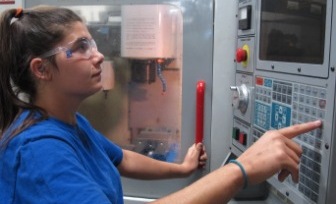Schools, Business Develop Next-Generation Workers

This interview with CBIA’s Andrea Comer originally appeared in the Hartford Business Journal, Nov. 30, 2015.
Q: When you started as executive director of the CBIA Education & Workforce Partnership, you said, “Strengthening our state’s future workforce is critical to sustaining a vibrant economy.” What are some of the steps CBIA is taking to strengthen the future workforce?
We heard, for instance, that students need to be exposed earlier to the workplace.
In response, we now have a strong partnership with the Hartford Public Schools at the Academy of Engineering & Green Technology, a National Academy Foundation school that has a business-led advisory board and provides internships and project-based learning opportunities.
Hartford students twice have built wind turbines for Nepalese villages, projects that have not only allowed them hands-on experiences to implement what they have learned, but also to realize the impact they can have in the world.
We also have programs that address specific industry needs such as transportation and logistics and manufacturing.
Q: One effort CBIA is involved in is the Clean Trades Program. It integrates energy efficiency, water quality, environmental quality, and other green efforts into HVAC, plumbing, carpentry, electrical, and bioscience curricula. Why go green in these kinds of programs? Are we developing enough future workers in these fields to meet needs?
A: Connecticut has been focused on climate change for more than a decade, and this commitment has resulted in a demand for a skilled workforce.
The Clean Trades Program exposes students to sustainability projects focused on energy efficiency, water quality, environmental quality, waste and recycling, and school-site environment, all of which provide real-world experience in an industry that is expected to net more than 15,000 jobs by 2030.
These jobs include energy auditors, technical sales and marketing, home-energy technicians, and solar-PV installers.
Q: How long is the payback for these kinds of efforts? For programs initiated in 2016, when can we start to see results?
A: The payback depends on the program.
Our work is driven by industry needs, and our member businesses and our programs reflect that.
Our work with the Workforce Solutions Collaborative of Metro Hartford, which provides training in the transportation, distribution, and logistics sector, has resulted in increased wages and promotions for incumbent workers and a career path for the unemployed.
That said, we embark on this work recognizing that this is a marathon and not a sprint. We have an aging workforce and growing urban centers, but there’s a gap from a skills perspective.
We must address that gap if we are going to be economically competitive.
Q: What can be done to train the trainers? In effect, how willing is the business community to embrace new ideas in educating the future workforce?
A: The graying of the workplace has created a climate in which employers and educators are constantly collaborating on innovative ways to tackle this challenge.
An example of this is our teacher externship program, a partnership with the Regional Center for Next-Generation Manufacturing.
Educators spend the summer participating in workplace experiences that reinforce the alignment between curriculum and current workplace practices.
These projects allow teachers to gain insight into lean processes, quality management, and continuous improvement—skills employers have prioritized—and integrate them into their classrooms.
Q: What states or even countries are doing this kind of education well? Who can Connecticut look to for inspiration and guidance?
A: The United States is ranked 17th in education, behind other developed countries, and that was unheard of decades ago.
The schools that were built to prepare the future workforce for jobs in factories and farms have not evolved in tandem with the changing workplace.
NAF academies like the Academy of Engineering & Green Technology are redefining the school model.
They connect students to the workplace much earlier, and the P-TECH model allows students to gain an associate’s degree concurrently with their high school diploma.
There is no specific type of school that is the panacea, but we need flexibility that addresses each child’s educational needs.
RELATED
EXPLORE BY CATEGORY
Stay Connected with CBIA News Digests
The latest news and information delivered directly to your inbox.



